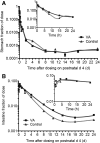Vitamin A supplementation redirects the flow of retinyl esters from peripheral to central organs of neonatal rats raised under vitamin A-marginal conditions
- PMID: 28298391
- PMCID: PMC5402035
- DOI: 10.3945/ajcn.116.149039
Vitamin A supplementation redirects the flow of retinyl esters from peripheral to central organs of neonatal rats raised under vitamin A-marginal conditions
Abstract
Background: Vitamin A (VA; retinol) supplementation is used to reduce child mortality in countries with high rates of malnutrition. Existing research suggests that neonates (<1 mo old) may have a limited capacity to store VA in organs other than the liver; however, knowledge about VA distribution and kinetics in individual, nonhepatic organs is limited.Objective: We examined retinol uptake and turnover in nonhepatic organs, including skin, brain, and adipose tissue, in neonatal rats without and after VA supplementation.Design: Sprague-Dawley neonatal rats (n = 104) were nursed by mothers fed a VA-marginal diet (0.35 mg retinol/kg diet) and treated on postnatal day 4 with an oral dose of either VA (6 μg retinyl palmitate/g body weight) or canola oil (control), both containing 1.8 μCi of [3H]retinol. Subsequently, pups (n = 4 · group-1 · time-1) were killed at 13 different times from 30 min to 24 d after dosing. The fractional and absolute transfer of chylomicron retinyl esters (CM-REs), retinol bound to retinol-binding protein (RBP-ROH), and total retinol were estimated in WinSAAM software.Results: VA supplementation redirected the flow of CM-REs from peripheral to central organs and accumulated mainly in the liver. The RBP-ROH released from the liver was acquired mainly by the peripheral tissues but not retained efficiently, causing repeated recycling of retinol between plasma and tissues (541 compared with 5 times in the supplemented group and control group, respectively) and its rapid turnover in all organs, except the brain and white adipose tissue. Retinol stores in the liver lasted for ∼2 wk before being gradually transferred to other organs.Conclusions: VA supplementation administered in a single high dose during the first month after birth is readily acquired but not retained efficiently in peripheral tissues of neonatal rats, suggesting that a more frequent, lower-dose supplementation may be necessary to maintain steady VA concentrations in rapidly developing neonatal tissues.
Keywords: chylomicron; extrahepatic; growth and development; mathematical modeling; neonate; retinyl esters; vitamin A deficiency; vitamin A metabolism; vitamin A supplementation.
© 2017 American Society for Nutrition.
Figures








References
-
- Stevens GA, Bennett JE, Hennocq Q, Lu Y, De-Regil LM, Rogers L, Danaei G, Li G, White RA, Flaxman SR, et al. . Trends and mortality effects of vitamin A deficiency in children in 138 low-income and middle-income countries between 1991 and 2013: a pooled analysis of population-based surveys. Lancet Glob Health 2015;3:e528–36. - PubMed
-
- Dahro M, Gunning D, Olson JA. Variations in liver concentrations of iron and vitamin A as a function of age in young American children dying of the sudden infant death syndrome as well as of other causes. Int J Vitam Nutr Res 1983;53:13–8. - PubMed
-
- Berggren Söderlund M, Fex GA, Nilsson-Ehle P. Concentrations of retinoids in early pregnancy and in newborns and their mothers. Am J Clin Nutr 2005;81:633–6. - PubMed
MeSH terms
Substances
Grants and funding
LinkOut - more resources
Full Text Sources
Other Literature Sources
Medical

